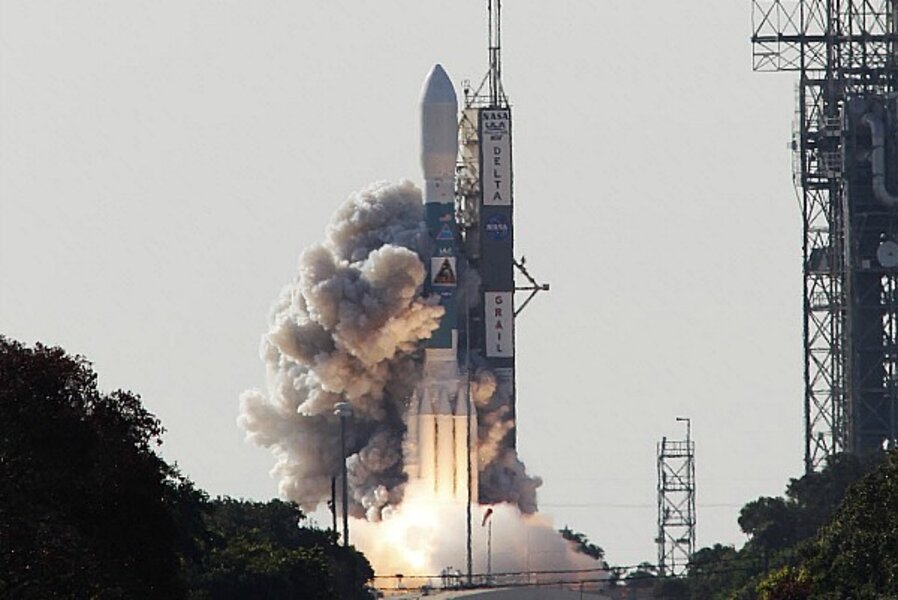GRAIL space mission will paint a fuller picture of the moon
Loading...
Luna, meet the GRAIL twins.
NASA's GRAIL mission to study the interior of the moon lifted off from the Kennedy Space Center at 9:09:32 Eastern Daylight Time on Saturday – marking the first time in the history of solar-system exploration that a space probe has been dedicated to plumbing the depths of a planetary interior.
The $496 million mission relies on a pair of identical orbiters that will swing, single-file, around the moon's poles for some 82 days gathering exquisitely precise measurements of the moon's gravity field. (GRAIL stands for Gravity Recovery and Interior Laboratory.)
These measurements will fill yawning gaps in the portrait of the lunar interior researchers have painted so far, according to Maria Zuber, a planetary scientist at the Massachusetts Institute of Technology and GRAIL's lead scientist.
The structure that lies beneath a planetary crust speaks volumes about its formation and evolution – a story that surface features can only partially tell.
With no internal geological processes vigorous enough to continually renew its surface, as happens on Earth, "the moon is a fantastic body in terms of learning about early planets," Dr. Zuber says. "It's nearby, it's accessible, and it preserves the record of what early planets were like."
Since the dawn of the Space Age, more than 100 missions have gathered data on the moon's surface. These missions have yielded important insights into the moon's geophysical history. So have experiments Apollo astronauts left on the lunar surface and the rocks they returned to Earth.
GRAIL will provide information that will allow planetary scientists to weave these other lines of evidence into a deeper, more complete story.
"In the next five years we're really going to rewrite the book in our understanding of the early planets," Zuber says.
To make their measurements, the mission's twins will use radio signals to continuously measure the distance between them and how that distance changes with the density of the portion of the moon directly beneath them.
The pair can behave a bit like a camera's zoom lens, changing the size of the area their measurements cover by changing altitude and the distance separating them, explains Sami Asmar, GRAIL's deputy project scientist at the Jet Propulsion Laboratory in Pasadena, Calif. The craft will be swinging around the moon at heights ranging between 7 and 32 miles and with separation distances of between 40 and 140 miles.
One mystery researchers hope GRAIL will help solve involves the Case of the Two Moons.
In early August, a pair of scientists suggested that the moon had a smaller companion early in its history that shared the same orbit.
Based on modeling studies, they concluded that a slo-mo collision between the two could explain several puzzling features scientists have noted about the moon's surface and interior:
• The near side has extensive, volcanically produced maria, or "seas," while the far side doesn't.
• The far side boasts unusually high highlands, as well as the deepest impact basin.
• Deep inside the moon, some of the denser radioactive material making up the core appears to have migrated toward the near side, as if it had been shoved from behind. This region of hot rocks closer to the surface has been cited as a reason why maria appear mainly on the near side of the moon.
The two scientists who ran the modeling experiment posit that the young moon, covered by a now-solidified magma ocean, was struck by its smaller companion at speeds slow enough to prevent cratering and allow the moon's gravity to keep its grip on the collision rubble.
As the collision evolved, most of the material remained on the far side to cover the magma ocean and form the highest of the moon's highlands. The remaining rubble circulated toward the near side to form the bright highlands, while leaving patches of the magma ocean exposed to cool and form the darker regions.
The duo published their results in the Aug. 4 issue of the journal Nature.
This explanation for the differences in appearance between the near and far lunar hemispheres makes specific predictions the GRAIL mission can test.





